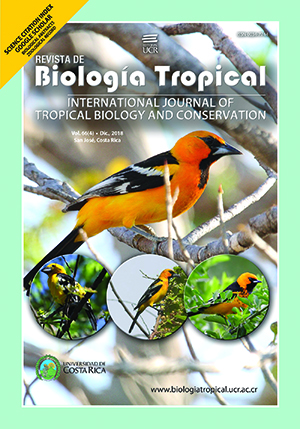Abstract
Chemical defense is a widespread mechanism on many animals and plants. However, just a few cases are known for avian species. In this study we evaluate the toxicity of Pheucticus chrysopeplus feather extract via lethality test with brine shrimp (Artemia salina) as an in vivo model. Mortality of A. salina was evaluated after 24 hour exposure to artificial seawater, methanol, and the methanolic feather extract. Kruskal-Wallis test showed a significant difference in mortality between treatments (X2 = 65.25, P < 0.0001, n = 50). With this we describe P. chrysopeplus as the first known toxic avian species of Guatemala and Central America, raising awareness about its conservation and the identification of the toxic substance present in its feathers. We also highlight the possible mimicry mechanism taking part between P. chrysopeplus and two sympatric oriole species (Icterus pectoralis and I. pustulatus).
References
Ariano-Sánchez, D., & Salazar, G. (2015). Spatial ecology of the endangered Guatemalan Beaded Lizard Heloderma charlesbogerti (Sauria: Helodermatidae), in a tropical dry forest of the Motagua Valley, Guatemala. Mesoamerican Herpetology, 2(1), 64-74.
Audesirk, T., Audesirk, G., & Byers, B. (2003). Biología. La vida en la Tierra. México D.F.: Pearson Educación.
Bartram, S., & Boland, W. (2001). Chemistry and Ecology of Toxic Birds. ChemBioChem, 2, 809-811.
CONAP. (2009). Lista de especies amenazadas (LEA) y Listado de flora y fauna silvestres CITES de Guatemala. Guatemala: Departamento de vida silvestre - CONAP.
Dumbacher, J., Beehler, B., Spande, T., Garraffo, H., & Daly, J. (1992). Homobatrachotoxin in the genus Pitohui: Chemical defense in birds? Science, 258, 799-801.
Dumbacher, J., & Fleischer, R. (2001). Phylogenetic evidence for colour pattern convergence in toxic pitohuis: Mülerian mimicry in birds? Proceedings of the Royal Society of London, 268, 1971-1976.
Dumbacher, J. P., Menon, G. K., & Daly, J. W. (2009). Skin as a toxin storage organ in the endemic New Guinean Genus Pitohui. The American Ornithologists’ Union, 126(3), 520-530.
Fagan, J., & Komar, O. (2016). Field Guide to Birds of Northern Central America. New York: Peterson Field Guides.
FAO. (2007). Wild birds and avian influenza. Rome, Italy: FAO.
Geethaa, S., Jayanthi, P., Poh, S., & Ming, O. (2013). Interference from ordinarily used solvents in the outcomes of Artemia salina lethality test. Journal of Advanced Pharmaceutical Technology & Research, 4(4), 179-182.
Gopalakrishnakone, P. (2015). Toxinology. New York: Springer.
Hamidi, M., Jovanova, B., & Kadifkova, T. (2014). Toxicological evaluation of the plant products using Brine Shrimp (Artemia salina L.) model. Macedonian Pharmaceutical Bulletin, 60(1), 9-18.
Omland, K., & Lanyon, S. (2000). Reconstructing plumage evolution in orioles (Icterus): repeated convergence and reversal in patterns. Evolution, 54(6), 2119-2133.
Price, J., Friedman, N., & Omland, K. (2007). Song and plumage evolution in the new world orioles (Icterus) show similar lability and convergence in patterns. Evolution, 61(4), 850-863.
Savitzky, A., Mori, A., Hutchinson, D., Saporito, R., Burghardt, G., Lillywhite, H., & Meinwald, J. (2012). Sequestered defensive toxins in tetrapod vertebrates: principles, patterns, and prospects for future studies. Chemoecology, 22, 141.
Skelhorn, J., & Rowe, C. (2007). Predators’ toxin burdens influence their strategic decisions to eat toxic prey. Current Biology, 17, 1479-1483.
UCLA. (2015). Feather sampling protocol. California: University of California.
Weldon, P. J. (2000). Avian chemical defense: Toxic Birds not of a feather. PNAS, 97(24), 12948-12949.
Wilsdon, C. (2009). Animal behavior. New York: Chelsea House Publishers.
Wu, C. (2014). An important player in brine shrimp lethality bioassay: The solvent. Journal of Advanced Pharmaceutical Technology & Research, 5(1), 57-58.
##plugins.facebook.comentarios##

This work is licensed under a Creative Commons Attribution 4.0 International License.
Copyright (c) 2018 Revista de Biología Tropical






